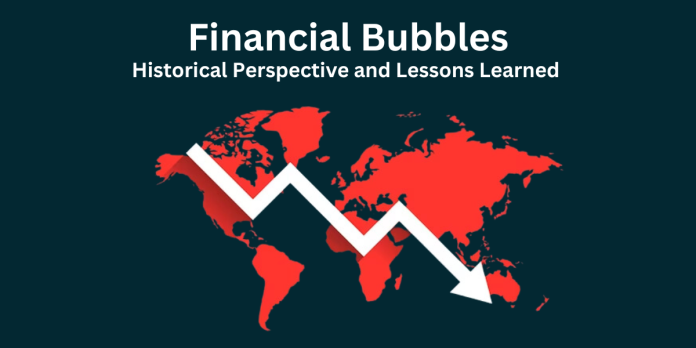Financial bubbles are characterised by a rapid increase in the price of an asset, followed by a sudden and dramatic decline. They can occur in any asset class, including stocks, bonds, real estate, and commodities.
Bubbles are often driven by psychological factors such as greed, fear, and euphoria. This is why it is important for investors to be aware of their own biases and to make investment decisions based on rational analysis, not emotion. However, there are some warning signs that can indicate that a bubble is forming, such as rapidly rising asset prices, excessive speculation, and a widespread belief that the asset class is only going to go up.
Bubbles can burst quickly and unexpectedly. This is why it is important for investors to have an exit strategy in place in case they believe that a bubble is forming.
Historical Examples of Financial Bubbles
- Tulip Mania (1636-1637): Tulip bulbs became a status symbol in the Netherlands, and their prices surged to unsustainable levels. The bubble burst when people began to sell their bulbs and prices plummeted.
- Mississippi Bubble (1719-1720): The Mississippi Company was granted a monopoly on trade with the Mississippi River Valley. Speculation in the company’s shares drove up their prices to unsustainable levels. The bubble burst when the government was unable to redeem the shares for gold, and prices collapsed.
- British Railway Mania (1840s): The construction of railways in Britain led to a surge in investment in railway companies. However, many of these companies were poorly managed and unprofitable. The bubble burst when investors began to sell their shares, and prices plummeted.
- Wall Street Crash of 1929: The stock market crash of 1929 was a major factor in the Great Depression. The crash was caused by a combination of factors, including overproduction, speculation, and bank failures.
- Japanese Asset Price Bubble (1980s): The Japanese asset price bubble of the 1980s was caused by deregulation, easy money, and speculation. The bubble burst in 1990, leading to economic stagnation.
- Dot-com Bubble (1990s): The dot-com bubble was a surge in investment in technology companies in the 1990s. The bubble burst in 2000, leading to a bear market and a loss of billions of dollars.
- Housing Bubble Crisis of 2007-2008: The housing bubble crisis of 2007-2008 was caused by a combination of factors, including subprime lending, risky mortgage-backed securities, and predatory lending practices. The bubble burst in 2007, leading to a recession, millions of foreclosures, and a financial crisis.
Common Causes of Financial Bubbles
- Easy credit: When credit is easy to obtain, investors are more likely to borrow money to invest in assets, which can drive up prices.
- Speculation: Speculation is the buying of an asset in the hope of selling it for a profit at a later date. When there is a lot of speculation in an asset class, it can drive up prices beyond their fundamental value.
- Euphoria: Euphoria is a feeling of extreme optimism and excitement that can lead investors to make irrational decisions. When investors are euphoric about an asset class, they may be more willing to pay high prices for assets.
- Information asymmetry:Information asymmetry is a situation in which some investors have more information about an asset than others. This can give certain investors an advantage, which can lead to market inefficiencies and bubbles.
- Decrease in liquidity: Liquidity is the ease with which an asset can be converted into cash. When liquidity decreases, it can make it more difficult for investors to sell their assets, which can lead to a decline in prices.
Lessons from Financial Bubbles
- Be wary of asset prices that are rising rapidly and without any underlying justification. This is a classic sign of a bubble.
- Do your own research before investing in any asset, and don’t just follow the crowd. Understand the risks involved and only invest what you can afford to lose.
- Be sceptical of investment products that are complex or difficult to understand. If you don’t understand how it works, don’t invest in it.
- Don’t use leverage to invest in assets that are risky. Leverage can amplify your gains, but it can also amplify your losses.
- Have a diversified investment portfolio. This will help to reduce your risk if one asset class performs poorly.
Conclusion
Financial bubbles are a recurring phenomenon in history. They can have a devastating impact on the economy, causing businesses to fail, jobs to be lost, and people to lose their savings. By understanding the causes of bubbles and the lessons that can be learned from them, investors can better protect themselves from the financial losses that can occur when bubbles burst.
Disclaimer: This blog has been written exclusively for educational purposes. The securities mentioned are only examples and not recommendations. It is based on several secondary sources on the internet and is subject to changes. Please consult an expert before making related decisions.


